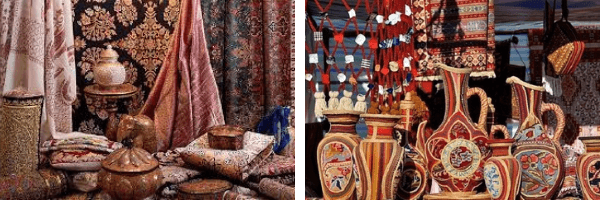
The handicraft sector plays a vital role in generating income and providing employment opportunities and has also been recognized worldwide as a tool for reducing poverty rate. It is one way of preserving and promoting cultural and artistic traditions because,for many countries, the significant unique cultural heritage is retained through their handicrafts. This article will deal with handicrafts specifications of some countries.
1) Handicrafts in Tunisia and Morocco
Tunisia is famous by its Berber rugs and its oriental carpets which come in a “Mergoum” type that are purely handwoven and I should not forget to mention that carpet making is very famous in Kairouan region. In fact, this type of flooring furniture dates back to the Paleolithic area and were usually made for tribes using natural fibers to create not just rugs but cloaks and other fabrics as well. So,when it comes to home buying, purchasing rugs is one of the best decisions you can make while you are in Tunisia. These rugs are not only of high quality but very comfortable and very gorgeous.You will astonish your guests with these unique Berber carpets made with a mixture of traditional and modern style.
Morocco is ,also, one of the main countries that exports handmade carpets abroad. The Berber tribes in the Atlas Mountains have been able to transmit, from mother to daughter, an exceptional knowledge of weaving and wool trades. Berber rugs and Moroccan carpets, known in arabic as “zarabia”, are major elements of cultural heritage. Men and women in Morocco work together. Women weave and model carpets while man sell them in “Souk”.
2) Handicrafts in Turkey
Turkey is most famous by its towels which were famous accessories worn by women during the Ottoman empire. Towels are used in different settings including the house, beach, yoga and gym classes. They have various different names, the most common one is a peshtemal. A peshtemal is the traditional name given to the woven towel that was originally used to cover the body in a Turkish hammam. Peshtemals have a history of nearly 600 years and originated in Anatolia, Turkey. There are similar towels in different regions of the world that are called by different names: in Asia they are called a sarong, a kikoy or kanga in East Africa, shukas towel in Africa, and fouta is the term generally used in the Mediterranean region.
3) Handicrafts in Italy, Spain and Portugal
Italy has a long, rich history with ceramics, one that is revered by many all over the world. Italy, in fact, is mainly known by the “ Maiolica” which is a tin-glazed pottery that dates back to the Renaissance period. It is decorated with different colors on a white background. Italian potters were mainly inspired by the spanish who were famous by the production of these colorful ceramics.
Andalucia, Spain is most famous by its ceramics. All around the region, you can find pretty, colourful bowls, plates and mugs, small gift ideas and interior Andalucian touches for home decoration.
Portugal is most famous by its unique handmade ceramics with its colorful and unique designs. Travelling around the Algarve town; you will find glazed tiles everywhere- in churches, houses and cafés. Portugal is ,also, well known by the Porches Pottery that was founded in 1968 by two artists, Irish Patrick Swift and Portuguese Lima de Freitas. Their first aim was to preserve the traditional Algarve pottery industry that was changing in favour of more modern techniques.
3) Handicrafts in India
India is most known by the textile production namely the production of Pashmina Shawls made from the wool of the goats of Kashmir (Northern region of India). As the name states it, Pashmina shawls are very soft and can keep you warm. These Shawls come in a variety of designs and colors and can be worn as a scarf around the neck or can be simply wrapped around the arms. In addition, this type of clothing was linked to royalty, so; they were only worn by kings and queens in earlier times. Nowadays, Indian women relate Pashmina shawls to luxury and elegance.
All in All, handicrafts of every country of the world give an overview about the country’s whole history, culture and civilization. These handmade products, also, reflect the influence of Empires through time. Every country remains distinguishable, unique and has its own traits in terms of handicrafts production.
